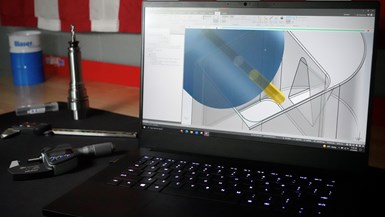How to Tackle Tough Angled Pocket Milling With Two Tools
Milling a deep pocket with a tight corner radius comes with unique challenges, but using both a flat bottom drill and a necked-down finishing tool can help.
Reader Question
I have an application where I am milling a deep pocket in 6061 with a tight corner radius — 3/16 inch — into an angled surface. The maximum depth of the pocket is 1 inch deep (5× deep). The pocket is inside of another pocket, so toolholder clearance is also a problem. What’s more, the cut is very prone to chatter. How can I successfully mill this pocket?
Miller’s Advice
Pockets like this are tricky because of so many competing factors, but identifying the overlying issues and constraints is a good first step to developing a solution. Ideally, you could use a larger tool, but you’re constrained by the pocket radius. Shortening the tool stick could help, but the primary pocket makes this impossible. The angled surface also leads to some interesting limitations as far as tool selection.
Even after you’ve selected the tool, the cut is prone to chatter, so you must determine the magnitude and direction of the cutting forces, as well as the system’s stiffness. Getting the cutting forces up into the spindle can be a huge benefit in this application, just like high feed milling in hard metals. Any cutting forces normal to the tool are the enemy. While you can’t eliminate all normal forces — given the pocket geometry, you must finish-mill the cut — you can reduce them. Anything you can do to add rigidity near the cut will also improve stiffness. Because this is a pocket within a pocket, you’ll also face significant clearance limitations.
With these difficulties in mind, it’s time to dive into the different components, and solve each as best as possible given the constraints.
The first thing you are up against is the tool diameter. Unfortunately, barring any design changes, the 3/16-inch tool at 5× deep is here to stay. Since you can’t change it, work with it. You want to reduce the amount of work you’re asking of this tool as much as possible.
One reduction strategy would be to use separate tools for finishing and roughing. A two-tool strategy will reduce the load on the tiny finisher and provide better tool life. It could even shorten the cycle time compared to a single-tool process — roughing’s increased productivity can counterbalance any time added for tool change and positioning.
Next, address the pocket. Since your challenging pocket is within another pocket, you can’t change much with the tool holder to increase stiffness. Yet you still need as much support as you can get, as close as possible to the cutting point. In this instance, a necked-down end mill (an end mill with a larger shank than cutting diameter) is wise. This will give you more stiffness where the tool holder can’t fit without rubbing against other critical features of the part.
The angled surface is the most unique aspect of this cutting problem. Drilling out difficult pockets is typically a good solution. Drilling provides high removal rates, and the forces go where the machine and tool setup are strongest. In fact, it’s a common strategy in large titanium or hard metal parts. However, the angled surface changes that formula a bit. Fortunately, indexable drills or solid carbide flat-bottom drills are up to the task. These drills also have the benefit of being able to drill overlapping holes! Given how small this pocket is, perhaps a carbide flat-bottom drill is ideal here. It can fit tightly into that 3/16-inch radius and leave minimal material in the area at highest risk for chatter.
Bringing together these solutions, start by switching to a two-tool process. The first tool should be a 4- or 4.5-mm flat bottom drill (just smaller than the finish radius) for roughing the entire pocket, leaving only small scallops and a little floor material left for finishing. The second, necked-down finishing tool will greatly improve the overall stiffness, and when combined with the minimal finishing stock, should enable a more productive finishing operation.
Related Content
Choosing Your Carbide Grade: A Guide
Without an international standard for designating carbide grades or application ranges, users must rely on relative judgments and background knowledge for success.
Read MoreAll-Around Mill Improves Productivity and Cost for Valve Job
Adopting a mill with a double-negative rake and pockets compatible with multiple insert geometries enabled Progressive Metal Service to increase feed and lower scrap rates for a valve.
Read MoreTwin Spindle Design Doubles Production of Small Parts
After experiencing process stalls in the finishing stage of production, Bryan Machine Service designed an air-powered twin spindle and indexable rotating base to effectively double its production of small parts.
Read MoreNew Modular Tool Options for Small Spindle Milling
Tooling options have been limited for small spindle milling applications. Now modular, indexable systems are available that provide broad flexibility to get the right cutter for the job with less inventory and at lower cost.
Read MoreRead Next
3 Mistakes That Cause CNC Programs to Fail
Despite enhancements to manufacturing technology, there are still issues today that can cause programs to fail. These failures can cause lost time, scrapped parts, damaged machines and even injured operators.
Read MoreThe Cut Scene: The Finer Details of Large-Format Machining
Small details and features can have an outsized impact on large parts, such as Barbco’s collapsible utility drill head.
Read More















.png;maxWidth=300;quality=90)











